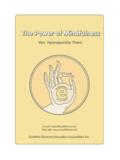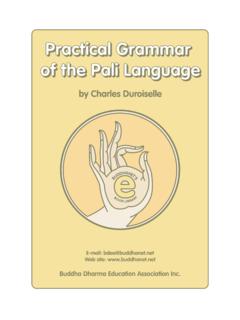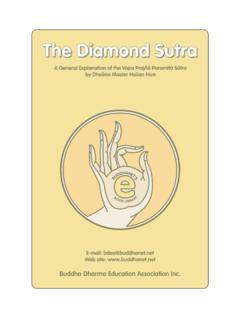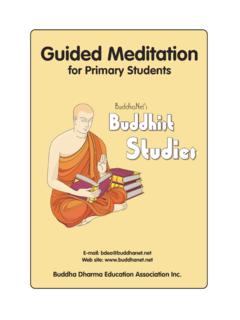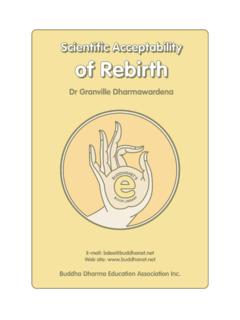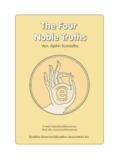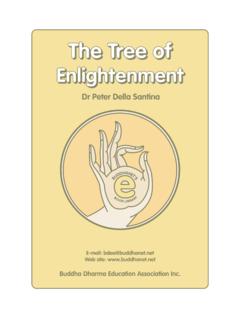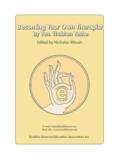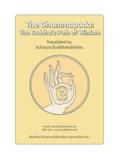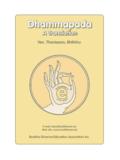Transcription of Compiled by U Ko Lay
1 EBUDDHANET'SBOOKLIBRARYE-mail: site: Dharma Education Association by U Ko LayGuide to TipitakaGuide to Tipitaka4 Namo Tassa Bhagavato Arahato Sam sambuddhassaVeneration to the Exalted One, theHomage-Worthy, the Buddha is an Arahat and he is worthy of the highest veneration. Allbeings including devas and Brahm s venerate the Buddha because theBuddha is the Supreme One, who has extinguished all defilements, who hasbecome perfectly self-enlightened through realization of the Four NobleTruths, and who is endowed with the six great qualities of glory, namely,Issariya (supremacy), Dhamma (Knowledge of the Path to Nibb na), Yasa(fame and following), Sir (noble splendour of appearance), K ma (power ofaccomplishment) and Payatta (diligent mindfulness).5 CONTENTSPagePreface 18 Chapter IWHAT IS VINAYA PI AKA?Vinaya Pi aka, Disciplinary and Procedural Rulesfor the Sa gha 21(a) Seven Kinds of Transgression or Offences, patti 21(b) When and how the disciplinary rules were laid down 22(c) Admission of bhikkhun s into the Order 22 Chapter IIVINAYA PI AKA1.
2 P r jika P i 25(a) P r jika offences and penalties 25 Four P r jika offences which leadto loss of status as a bhikkhu 25(b) Thirteen Sa gh disesa offences and penalties 26 Some examples of the Sa gh disesa offences 26(c) Two Aniyata offences and penalties 27(d) Thirty Nissaggiya P cittiya offences and penalties 27 Some examples of the Nissaggiya P cittiyaoffences 282. P cittiya P i 28(a) Ninety-two P cittiya offences and penalties 28(b) Four P idesan ya offences and penalties 29(c) Seventy-five Sekhiya rules of polite behaviour 296 ContentsPage(d) Seven ways of settling disputes, Adhikara asamatha 29(e) Rules of Discipline for bhikkhun s 303.
3 Mah vagga P i 324. Cu avagga P i 335. Pariv ra P i 33 Chapter IIIWHAT IS SUTTANTA PI AKA? 34(a) Observances and Practices in the Teaching of the Buddha 34(b) On the right way to give alms 35(c) Moral Purity through right conduct, S la 36(d) Practical methods of mental cultivation for development ofconcentration, Sam dhi 37(e) Practical methods of mental cultivation for development ofInsight Knowledge, Pa 38 Chapter IVSUTTANTA PI AKAD gha Nik ya, Collection of long discourses of the Buddha 40(a) S lakkhandha Vagga P i, Division Concerning Morality 401.
4 Brahmaj la Sutta, Discourse on the Net of Perfect Wisdom 402. S ma aphala Sutta, Discourse on the Fruits of the Life of a Samana 423. Ambattha Sutta 434. So ada a Sutta 435. K adanta Sutta 437 ContentsPage6. Mah li Sutta 447. J liya Sutta 458. M has han da Sutta 459. Po hap da Sutta 4610.
5 Subha Sutta 4611. Keva a Sutta 4612. Lohicca Sutta 4713. Tevijja Sutta 47(b) Mah Vagga P i, The Large Division 481. Mah pad na Sutta 482. Mah nid na Sutta 483. Mah parinibb na Sutta 494. Mah sudassana Sutta 505. Janavasabha Sutta 516.
6 Mah govinda Sutta 517. Mah samaya Sutta 518. Sakkapa ha Sutta 529. Mah satipa h na Sutta 5210. P y si Sutta 53(c) P thika Vagga P i 531. P thika Sutta 532. Udumbarika Sutta 533. Cakkavatti Sutta 544. Agga a Sutta 545.
7 Sampas dan ya Sutta 556. P s dika Sutta 557. Lakkha a Sutta 568. Si g la Sutta 568 ContentsPage9. n iya Sutta 5610. Sa g ti Sutta 5711. Dasuttara Sutta 57 Chapter VMajjhima Nik ya, Collection of Medium Length Discourses of the Buddha 58(a) M lapa sa P i 58I.
8 M lapariy ya Vagga1. M lapariy ya Sutta 582. Sabb sava Sutta 583. Dhammad y da Sutta 584. Bhayabherava Sutta 595. Ana ga a Sutta 596. ka kheyya Sutta 597. Vattha Sutta 598. Sallekha Sutta 599. Samm di hi Sutta 6010. Mah satipa h na Sutta 60II.
9 S han da Vagga1. C as han da Sutta 602. M has han da Sutta 603. Mah dukkhakkhandha Sutta 614. C adukkhakkhandha Sutta 615. Anum na Sutta 616. Cetokhila Sutta 617. Vanapattha Sutta 628. Madhupi ika Sutta 629 ContentsPage9. Dvedh vitakka Sutta 6210. Vitakkasa h na Sutta 62 III.
10 Opamma Vagga1. Kakac pama Sutta 632. Alagadd pama Sutta 633. Vammika Sutta 634. Rathavin ta Sutta 635. Niv pa Sutta 646. P sar si Sutta 647. C ahatthipadopama Sutta 648. Mah hatthipadopama Sutta 659. Mah s ropama Sutta 6510. C as ropama Sutta 65IV.
